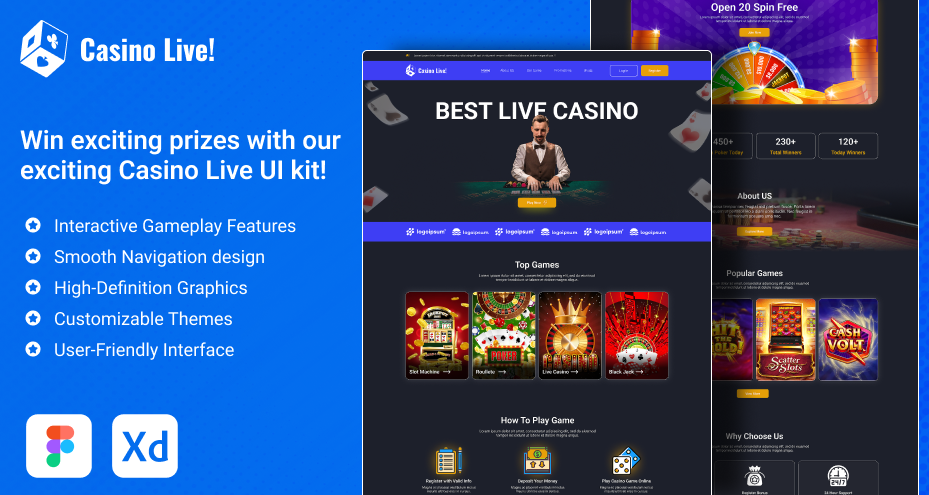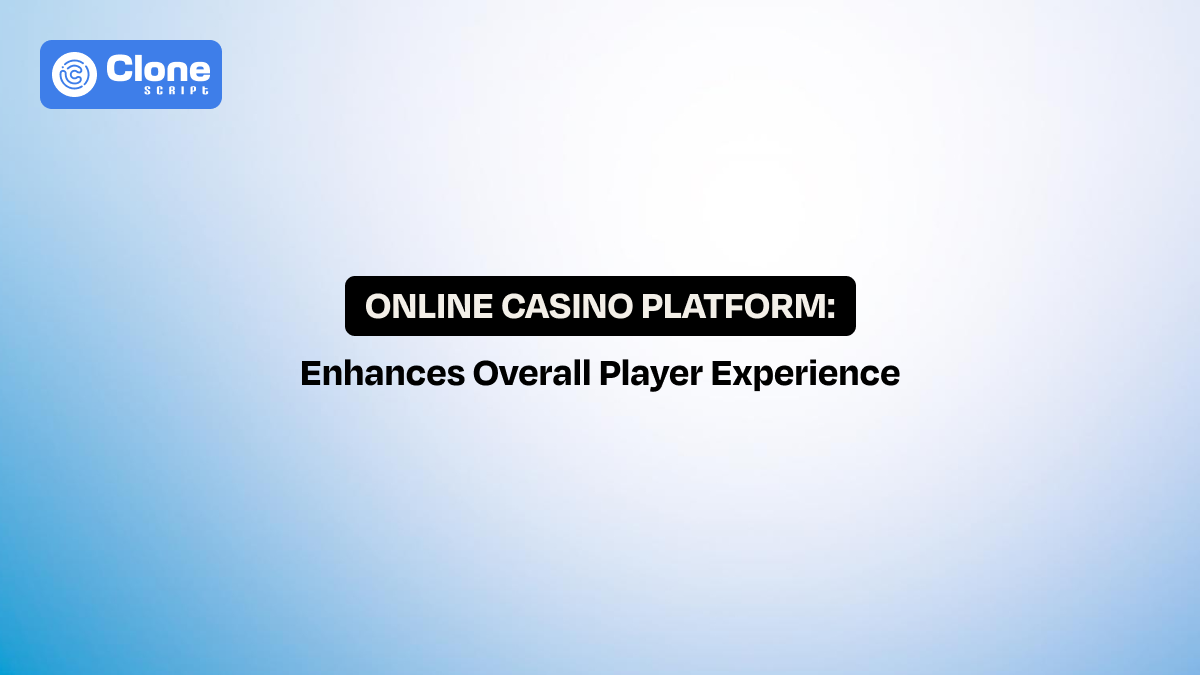Top 7 Features of an Online Casino Website That Boost Trust & Player Retention
In 2025, the online casino market will have become one of the most competitive industries on the web. With over 3,000 active casino websites worldwide, players now have more choices than ever before. This means one truth for developers: design alone is not enough.
If you’re building or optimizing an online casino website, your primary goals should be:
-
Earn trust quickly – because players are cautious about where they deposit money.
-
Retain players consistently – The acquisition costs are high, and loyalty drives profitability.
This blog gives knowledge about seven essential features that web developers must incorporate into casino websites to establish credibility and enhance player retention. Each feature combines trust signals with long-term engagement strategies. It means your gambling website design not only looks appealing but also drives revenue.
Why Trust Matters in Online Casino Websites?
Trust is the invisible currency of online gambling. Unlike retail or e-commerce, players aren’t just spending money—they’re wagering it with expectations of fairness, security, and transparency. Without visible trust features, even the most beautifully designed casino will struggle to attract repeat users.
Here are key reasons why trust matters in gambling.
-
Licensing & Compliance: Players actively look for licensing details from recognized authorities like the UKGC or MGA. Displaying this information prominently shows legitimacy and proves the platform is not a rug puller (who take money and run away).
-
Security Perception: Secured casino website features like HTTPS, visible SSL seals, and 2FA integration communicate safety. In fact, research shows that over 80% of users abandon websites that feel insecure during checkout or payment stages.
-
Transparency of Gameplay: Online casinos that openly publish RTP rates and RNG certifications have significantly higher user retention. Players feel reassured when they know games are fair and unbiased.
-
Responsible Gambling Features: Deposit limits, session timers, and self-exclusion options don’t just meet compliance—they actually increase trust by showing players the site isn’t predatory. Also, governments appreciate the casino sites implementing responsible gambling practices.
For developers, every design and feature choice is a trust signal. Clean website UI design, transparent information architecture, and secure payment integration are all important to making players stay.
Once know the trust factor role in a casino web development, let’s take one step ahead to understand the importance of player retention.
Why Player Retention is Important in Online Casino Websites?
In gambling, repeat players are equal to long-term revenue. It costs far more to acquire new users than to retain them, and in such a saturated market, loyalty is the difference between profit and failure of your casino platform.
Here are some indicators that suggest why retention matters:.
-
Lifetime Value (LTV): According to various reports, retained players spend more over time than new ones. For example, a player depositing $50 a month for 12 months is worth more than one who deposits $200 once and never returns.
-
Reduced Churn: A stable user base provides consistent revenue and reduces reliance on aggressive marketing. It’s obvious that if the players are already enjoying their gambling experience on the platform, you don’t have to do paid social media ads and influencer marketing.
-
Reputation Building: Happy players share experiences in forums, reviews, and word-of-mouth that create opportunities to grow the user base without any extra costs. A retention-focused platform builds positive momentum.
-
Continuous Data Feedback: Retained users generate behavioral data that developers can use for personalization, targeted promotions, and UX improvements. So, if any issue persists (like the navigation glitch in the iPhone rather than Android devices), then it can be solved properly.
In essence, retention is not just about offering bonuses—it’s about designing a seamless experience that feels rewarding, safe, and engaging.
It’s okay to understand that trust is important for player retention in a casino. But how can you accomplish it? The answer is “casino website features.”
7 Features That Build Trust and Drive Player Retention
Here are the top features every casino platform has to win the trust and retain players deliberately:
-
User-Friendly Gaming Interface
-
Mobile-Friendly Website Design
-
High-Quality Visuals
-
Secure Payment Methods
-
Gamification Features
-
Multi-Language Support
-
Multi-Currency Support
Let’s explore these features in detail.
1. Professionally Designed User-Friendly Gaming Interface
The gaming interface is the first thing players interact with, and it sets the tone for their entire experience. A cluttered or confusing interface makes players feel frustrated and erodes trust.

-
Navigation on the focus: To retain users, casinos must deliver smooth navigation, logical menus, and intuitive layouts. Clear categories such as “Slots,” “Live Casino,” and “New Games” help players find what they want quickly.
-
User experience prioritized: Search bars and filters by provider give an immediate option player to guide them on what to do next.
-
Clear and realistic statistics: The RTP stats make browsing fair and professional. To get more players, don’t be tempted to add irrelevant stats that question the platform’s credibility.
-
Dashboard inclusivity: Developers should also integrate personalized dashboards that display recently played titles or recommended games. This makes returning users feel valued. Following UI/UX design rules for the dashboard works better and gives expected results, such as a higher engagement rate.
Most importantly, having a user-friendly website design is not enough if it’s not accessible to users. For that, compliance with WCAG standards ensures inclusivity, which broadens the player base. From a technical standpoint, optimizing performance with CDNs and PWA technology reduces load times and keeps the interface responsive across devices.
In short, a well-designed interface not only improves usability but signals professionalism, directly impacting trust and player retention.
2. Mobile-Friendly Website Design Presence
As a casino owner, you have the temptation, why should I go for a website instead of a casino app, which will generate more revenue? But the reality is, if your site is optimized for mobile-friendly practices, you don’t need an app. The casino app development takes time, and of course, it comes with extra costs.
-
With mobile devices accounting for 70–85% of online gambling sessions in 2025, a mobile-first design is non-negotiable. Players demand responsive layouts that adapt seamlessly across screen sizes. They want controls that are finger-friendly, and interfaces that don’t break on smaller displays.
In website development, a mobile-optimized design ensures the pages load as fast as possible, so players can access the platform on the internet. Here are some common tips to make your casino website responsive, and you can ask a development partner to manage it properly:
-
Compressed assets like unused CSS, lazy loading, and modern image formats (WebP/AVIF) help cut down latency. This improves overall site speed.
-
Developers should also implement cross-device continuity, allowing users to start a game on their phone and continue later on a desktop without losing progress.
Optional app-like features such as push notifications, biometric login, and offline caching via Progressive Web Apps (PWAs) create added convenience. However, even without an app, the mobile website must deliver a smooth, reliable experience. So, don’t take it just as an expanded reach factor but as an encouraging guide that brings back players to the platform and fits naturally into their daily routines.
3. High-Quality Visuals Availability
Most of the online casinos not just focus on the functionality but also on the visual presence, too. There are graphics, animations, videos, and other visual content that play a big role in conversions.
There’s no doubt that visual quality directly affects a casino’s credibility. Players associate professional design with security and fairness. But what if the site is not optimized yet?
A website with pixelated graphics, inconsistent branding, or outdated design patterns can easily be mistaken for a scam. So, even if you invested $100/day for Google Ads or Meta Ads, no one can take an interest in your platform. This results in shutting down the operation due to resource burn.
Here’s how you can avoid this pitfall.
-
Website designers and developers should focus on cohesive branding, using a consistent color palette, typography, and imagery throughout the site.
-
Game thumbnails should be high-resolution, while preview animations and banners should be optimized for performance.
-
Micro-interactions, such as hover effects or smooth transitions, add polish without overwhelming players.
However, visuals must balance quality with efficiency. Using lightweight formats (like WebP or AVIF) and vector-based SVG icons helps maintain crisp imagery without slowing website performance. Additionally, visuals should enhance gameplay without distracting from it—players need clarity, not chaos.
In essence, visuals are more than aesthetics—they are trust signals. A professional casino web design reassures players that the site is legitimate and worth returning to.
4. Secure Online Payment Methods
We know casino players are already in the mood to take risks for gambling and winning the prizes associated with it. But payment security on a website matters just like onboarding a flight with a boarding pass. According to research, half of the users are always worried about sharing their bank account details, credit/debit card information, just for playing gambling.
To convince those ones, the flawless and 0% vulnerable payment systems have to be integrated with the platform. If a deposit fails or withdrawals take too long, users rarely return. A reliable and secure payment gateway integration manages everything under a single roof.
Here is a common checklist to keep focus on:
-
When casinos support trusted gateways such as Visa, Mastercard, PayPal, Skrill, and Neteller, alongside local payment methods and even cryptocurrencies (where regulations permit), it creates trust. For that, developers must ensure PCI DSS compliance and encrypt all financial transactions with TLS protocols.
-
Transparency also matters. Players should see clear details on transaction fees, processing times, and minimum/maximum limits. This informs them for what they’re paying off.
-
Payment fraud prevention tools—like tokenization, 3D Secure, and real-time monitoring further reassure users that their money is safe.
But how can we forget to mention that the payment flow should be simple, intuitive, advanced, and consistent across devices from a professional UX perspective? Additionally, avoid redirect-heavy checkout processes that confuse players, as they sound suspicious.
Ultimately, secure payment methods are emotional assurances. When players trust that their money is handled properly, they return confidently.
5. Advanced Gamification Features
One thing that differentiates the well-recognized casino platforms from generic ones is “how positively the gamified elements are placed there.” After all, the developers have to design the platform for player retention, not just completing the project.
By introducing non-monetary incentives—such as achievements, points, and leaderboards keep users engaged beyond traditional gameplay. They have to prioritize the following when designing the casino websites:
-
Loyalty programs with tiered rewards (Bronze, Silver, Gold, VIP) encourage players to return and climb the ranks in the leaderboard.
-
Daily challenges and missions—like “Play 10 spins to unlock a bonus”—add structure and anticipation to the platform.
-
Achievements or badges tied to player activity create a sense of progress, even in losing streaks.
Developers can implement event-driven architecture so that rewards are triggered instantly when players hit milestones. Additionally, real-time leaderboards and tournaments add a social layer that appeals to competitive instincts and community participation.
Gamification works because it taps into psychology: progress, recognition, and reward loops keep users engaged. Sites that fail to gamify often struggle to stand out in a saturated market.
In essence, a well-executed casino gamification system turns casual users into loyal players, driving long-term retention.
6. Multi-Language Support to Expand Reach
If your casino business aims not to limit the reach to a particular region like the U.S., UK, or Europe but all over the world, the language can be a major factor to focus on.
Most of the online casinos operate globally, and language barriers can undermine both trust and retention. If a player struggles to understand game rules, payment details, or promotions in their preferred local language, they’re more likely to abandon the site.
Providing multi-language support is not just about machine translation—it requires cultural and contextual accuracy.
-
Important sections such as terms and conditions, payment policies, and customer support should be professionally translated. A visible language switcher should allow instant changes without breaking the interface.
-
For technical execution, developers must support right-to-left languages like Arabic and Hebrew, ensuring layouts remain functional. Beyond text, imagery, and promotions should also adapt to cultural expectations. For example, festive campaigns should align with regional holidays.
One thing to understand is that when offering localized customer support—chat or email in native languages—it further enhances trust. Players feel more confident when they know the casino “speaks their language” literally and figuratively.
In short, multi-language support transforms a platform from generic to inclusive, broadening its audience and boosting retention across regions.
7. Multi-Currency Support to Accept Payments
Players value convenience, and currency flexibility is a key part of that. Nobody wants to deal with hidden conversion fees or inconsistent exchange rates. Supporting multiple currencies is, therefore, an essential casino trust feature.
-
Casinos should cover global standards (USD, EUR, GBP) along with region-specific currencies like CAD, AUD, INR, or BRL. Developers can integrate APIs for real-time exchange rates, ensuring transparency in conversions.
Consistency is important across balances, wagers, and winnings, which should all reflect the user’s chosen currency.
Multi-currency systems must also comply with AML (Anti-Money Laundering) regulations, which vary across jurisdictions. Ensuring compliance while offering financial flexibility reassures players that the platform is both legitimate and customer-friendly.
From a design standpoint, displaying the selected currency clearly at all transaction points prevents confusion and improves user confidence.
Multi-currency support is more than convenience—it signals a casino’s commitment to fairness, transparency, and global accessibility, to boost retention.
Conclusion
An online casino website succeeds when it earns trust and delivers reasons for players to stay. For developers and businesses, this means prioritizing features that go beyond aesthetics—secure payments, seamless mobile design, gamification, multilingual and multi-currency support, professional visuals, and an intuitive interface.
Each of these elements strengthens credibility while improving the overall player experience. Together, they reduce churn, increase retention, and position a casino as a reliable, future-ready platform.
In short, trust brings players in, retention keeps them coming back. Developers who focus on these essentials will build casino websites that thrive in 2025 and beyond.
FAQs
-
What compliance factors directly affect casino web design?
Beyond trust, compliance is a legal necessity. Casino websites must adhere to GDPR for data protection, AML for transactions, and jurisdiction-based gambling laws. Developers should build compliance notices (cookies, age verification, license display) directly into the design to avoid future risks.
-
Which tech stack is best for developing an online casino website?
Most modern casino platforms use a MERN (MongoDB, Express, React, Node.js) or LAMP (Linux, Apache, MySQL, PHP) stack, combined with WebSockets for real-time gameplay. For mobile optimization, PWAs (Progressive Web Apps) are a strong choice, reducing reliance on native apps.
-
What’s the biggest development challenge in online casino websites today?
The biggest challenge is balancing compliance with user experience. Developers must integrate age verification, KYC onboarding, and geo-restrictions without creating friction for players. Achieving this balance requires thoughtful UX design, microservices for compliance modules, and automation tools that streamline player verification without slowing engagement.
-
What is the cost of a casino platform development, including website and app?
Developing a casino platform, including website and mobile app, typically costs $50,000–$250,000+. It depends on features, payment gateways, security, design, and scalability.
-
How to hire a casino web developer online?
Evaluating developers’ experience, portfolio, technical expertise, gaming compliance knowledge, and client reviews helps you to decide. For a secure, scalable, and user-friendly casino website and app developers, consider these factors.
-
Can a website template down the gambling platform development?
Yes. Using a responsive and user-friendly casino website template, the frontend development costs can be reduced by 50-60%. So, the saved amount can be utilized for more advanced features integration.
 BTC - Bitcoin
BTC - Bitcoin
 USDTERC20 - USDT ERC20
USDTERC20 - USDT ERC20
 ETH - Ethereum
ETH - Ethereum
 BNB - Binance
BNB - Binance
 BCH - Bitcoin Cash
BCH - Bitcoin Cash
 DOGE - Dogecoin
DOGE - Dogecoin
 TRX - TRON
TRX - TRON
 USDTTRC20 - USD TRC20
USDTTRC20 - USD TRC20
 LTC - LiteCoin
LTC - LiteCoin







